Running – It’s an exercise almost everyone thinks they can do, but very few actually do well.
It is also a repetitive exercise that can put lots of strain on our body and lead to injury, especially if we are already tight and suffering from imbalances and poor movement patterns because we sit at a desk hunched over a computer all day.
However, this doesn’t mean that you should just stop running, especially sprinting, if you love it.
It does mean though that you need to make sure to have a proper rehab/prehab program in place to include before and after your runs or even on days when you hit the gym.
By including certain foam rolling, stretching, activation and strength training moves in your workout routine, you can keep your body injury free and prevent and alleviate those annoying running injuries!
Follow our 4 Step Injury Prevention Program below to learn how to prevent and alleviate common running injuries.
How To Prevent And Alleviate Common Running Injuries – The 4 Step Program
Step 1 – Foam Rolling
Especially if you sit all day hunched over a desk, you first need to loosen up tight muscles before your run. This doesn’t simply mean foam rolling quickly before you hit the pavement.
If you want to get the benefits of foam rolling, you need to focus on rolling out muscles that are constantly tight every day. Even numerous times a day until you’ve made some progress. Once you’ve restored the muscles to their proper length-tension relationships, you may not need to roll as often but just enough to maintain.
Foam rolling, while not the most fun or glamorous part of a workout program, is a must-do step if you want to prevent injury. When you roll out, you help loosen tight muscles so that your body not only moves better, but can learn to recruit the correct muscles quickly.
By first starting with foam rolling, you can help improve your movement patterns by starting to correct imbalances, lessen your risk for overuse or compensation injuries AND even help yourself run faster because the correct muscles are able to start working!
Here are 10 Must-Do Foam Rolling Moves for Runners:
1. Foot – A very common running injury is Plantar Fasciitis. Another common injury is Achilles Tendonitis. Both can be a result of tight fascia under your feet. That is why runners need to make sure to roll out the bottom of their feet before and after runs and even on days when they don’t run if they wear dress shoes or high heels at work.
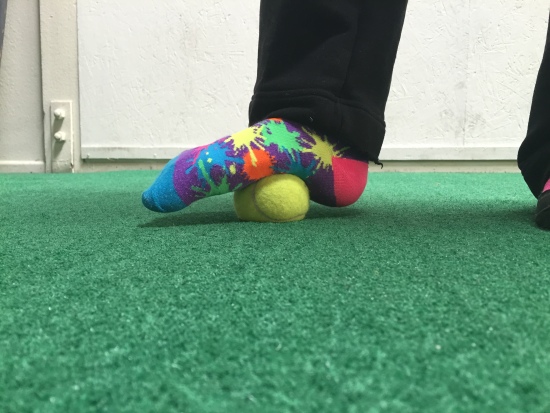
To roll out your foot, place a ball on the ground and place your foot on top of it. Roll it along the length of the bottom of your foot. Hold on any tight spots. Put more weight on the ball to dig in more.
Do not simply roll quickly back and forth. Move slowly and hold on any tight spots.
If you want to dig in more, try a smaller, harder ball. The smaller and harder the ball, the more pressure you will be able to apply.
You can also use a frozen water bottle to roll out your foot and ice at the same time. To do this, freeze a full bottle of water in the freezer. Then take it out and roll it under your foot like you would the tennis ball. (This works best with a thinner and round bottle).
2. Calves – If you wear high heels or dress shoes, your calves are probably already tight. And then you go out and run, which can only make them tighter. Tight calves can cause Foot, Ankle, Knee and even Hip and Low Back Pain. Because your feet and lower legs are your foundation, problems there can lead to pain and injury further up your body.

To roll out your calves, you can use a roller or a ball up on a yoga block or some books.
If you use a ball, place it up on some books or a yoga block and then put one calf on top of the ball. Start with the ball at the bottom part of the meat of your calf.
Cross the other leg on top to help apply more pressure.
Rock your leg very slightly from right to left or side-to-side a couple of times and then move the ball to another spot on your calf, working over the entire meaty part of the muscle. Keep rocking side to side as you work your way around your calf.
Hold on any tight spots. If you find a super tight spot, make circles with your foot and then tense and relax your calf (flexing and dropping your foot) before you move to the next spot. This will help the muscle relax itself and help the knot to release.
Don’t spend any time on areas that aren’t tight. Repeat all the way up and around both calves.
3. Shins/Peroneals – Shin Splints are another common running injury that you can help prevent by rolling out your shins and the sides of your lower legs. If you’ve rolled your ankle, you also want to make sure to take care of your lower leg, including your Shins and Peroneals.
While rolling your calf is important to prevent pain and injury further up your body so is taking care of the front and sides of your lower leg.
Shins:
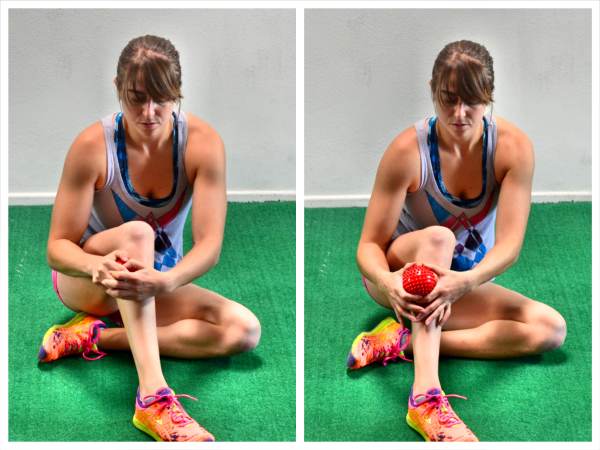
To roll out your shins, sit on the ground with one knee bent in front of you and the foot flat on the ground. Relax the leg and take a tennis ball in both hands.
With the ball in both hands, press it into the outside of your shin bone. Start digging it in to the muscle on the outside/front of your lower leg under your knee. Do not dig it into the bone.
Make small circles both ways with the ball, pressing as hard as you can into the muscle. Then move the tennis ball down your shin and again make small circles as you press the ball into the muscle. Make extra circles and even just simply hold the ball on any especially tight spots. You can also flex and relax your foot to tense and relax the muscle to help the muscle relax the knot.
Work your way down your shin to your ankle. Use a smaller, harder ball to dig in more.
You can also use a roller or even a ball on the ground to also roll out your shins. If you place the ball on the ground and then kneel with your shin on top, you will be able to apply more pressure.
Peroneals:
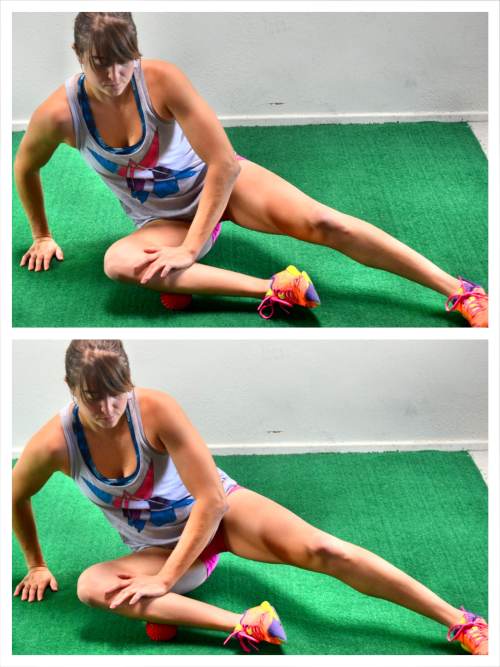
To roll out your Peroneal, place a ball on the ground in front of you and then bend your knee and place the side of your lower leg on top of the ball with the ball to the side below your knee. Relax your knee open and your leg down onto the ball as you press down on your lower leg with your hand to apply more pressure so that the ball digs in.
Then, using your hand to guide your leg, move your leg so that you make small circles on top of the ball. Work your way down the length of the side of your lower leg, pressing your lower leg firmly down into the ball with your hand.
You may even put a book under the ball to help you apply more pressure and get a better angle, especially if you are less flexible.
Hold on any tight spots and even flex and relax your foot to help dig into any tight areas. You can also circle the ankle while holding on any tight spots to dig in more to any knots.
To hit slightly different angles along the side of your shins, rock forward a bit (toward your shin) or backward (toward you calf).
Work your way along the length of your lower leg from just below your knee down to a few inches above the anklebone. Do not go right up to the anklebone.
Spend more time on tight areas. Do not waste time rolling out areas that aren’t tight.
4. IT Band, Lateral Quad, TFL – If you’ve ever suffered from knee or hip pain, you need to roll out your hips and the outside of your leg. And while many runners already spend time rolling out their IT Bands, it isn’t only the IT Band you need to target. All of the muscles around and connected to the IT Band could actually be causing the problems.
That is why you need to target your Lateral Quad and TFL as well.
A roller is best to roll out the outside of your upper leg although you can use a ball. A ball is best if you just want to focus on your TFL, but if you want to hit both areas at once, a roller is best.
When you roll out the Lateral Quad, you need to make sure to hit toward the front of your leg and even toward your hamstring on the outside.
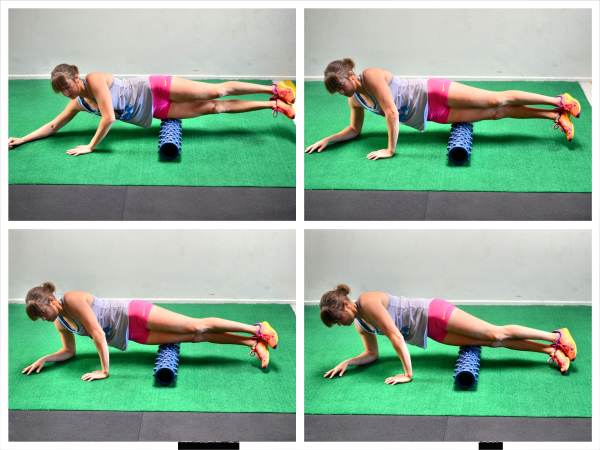
To roll out the Lateral Quad muscle and your TFL, lie on your side and place the foam roller under your legs just below your hip. Prop yourself up on your hand or forearm. Stack your legs one on top of the other to apply more pressure or place the top leg in front with the foot on the ground to lessen the pressure.
Rock forward slightly so the roller is right under your hip and toward the front of your quad but still on the side. By rocking forward with the roller under your hip, you can dig out your TFL. Again you can also use a ball on this area.
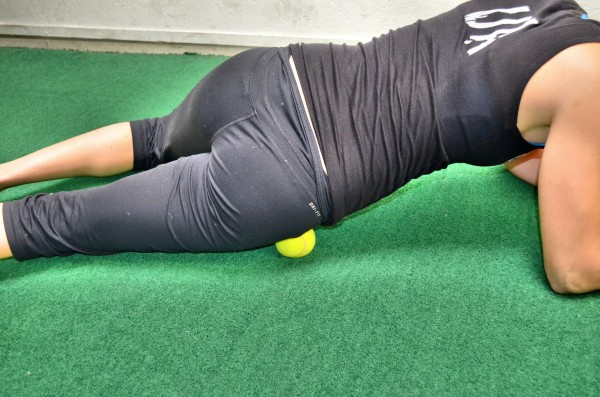
Hold on any tight spots. You can even rock slightly forward and backward as you hold.
Then begin to move the roller down the side of your leg. As you work your way down the outside of your leg, rock forward and backward to hit toward the front of your leg and then toward your hamstrings. Hold on any tight spots for a breath or two. Don’t just roll up and down quickly or you won’t really allow the muscles to release.
Don’t just simply roll up and down the side of your leg. Make sure to rock forward and backward to hit the entire lateral quad muscle.
Work your way down to right above your knee.
Spend more time on any areas of tightness.
5. Hamstring – Hamstring strains and pulls are common running injuries. Therefore it is super important that you take time to roll out your hamstrings before, after and between runs.
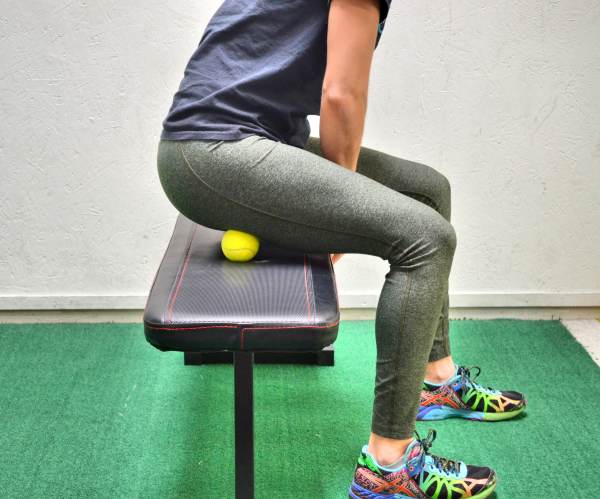
To roll out your hamstrings a ball works best as long as you can sit on the ball while sitting up on something like a chair, table or box. The pressure you can apply even when isolating one leg on a roller on the ground is limited so using a ball when seated up on something allows you to dig into your hamstring more.
However, you can also use a roller up on a box to dig in more than you would be able to on the ground.
If you use a ball, place the ball at the top of your hamstring right under the bottom of your butt while you are seated up on a chair. Rock side to side on the ball and roll it from your inner thigh out toward the outside of your leg.
Hold on any tight spot and perform small rocks side to side to help you dig into any knots. You can even flex and relax your hamstring to dig in further by straightening your leg out in front of you and then relaxing it back down.
Work your way down your hamstring toward your knee. Work all along your hamstrings, moving toward your inner thigh and out toward your IT Band.
Make sure to hold on any tight spots. Do not spend time on areas of your hamstring that aren’t tight. Work all the way down to your knee but don’t dig into the back of your knee.
If the pressure is too much when you sit on a ball on the chair, you can do this move from the ground and even simply place the ball up on a book so you can get a little more leverage to dig in.
Using a harder ball will help you dig in more while up on the box or chair.
6. Quad – If you sit all day at a desk and then go out and run, there is a chance you are very quad dominant. This can prevent your glutes from engaging and even lead to knee, hip and even low back pain.
It can also change your gait and prevent you from running as fast or as far as you may be able to!
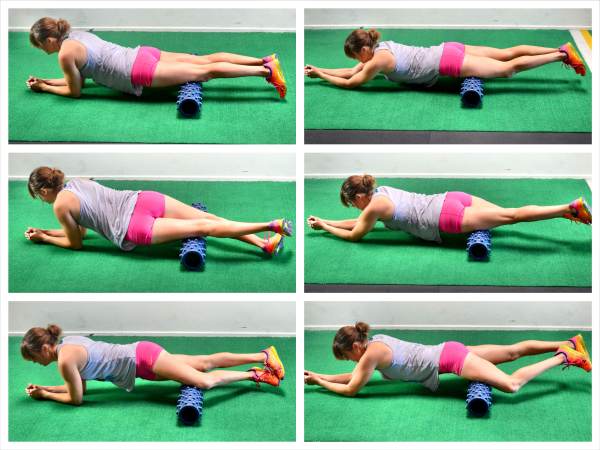
To roll out your quad, you can use a ball or a roller although a roller is best if you don’t have specific spots you want to target intensely.
Take the foam roller and lie over it as if you are about to do a plank.Start with the roller right above your knees. Keep your core engaged as you roll to protect your low back.
Then begin to rock side to side so that you work toward your inner and outer thighs. Hold on any tight spots and even make very small movements up and down on the roller while staying on the knot. Once you’ve held for a breath or two on the tight spot, move the roller up a little higher and again rock side to side.
As you rock and move the roller higher, make sure to pause and hold on any extra tight spots. Don’t simply roll quickly up and down.
Work your way all the way up to your hips and even rock toward the outside of your quads to get right up under your hip bone.
If you find any tight spots, while you hold on them, flex and relax your quad to help the tight spots loosen.
To apply more pressure, place only one leg down on the roller with the other leg crossed over and behind to help apply more weight and pressure. Still rock side to side, holding on any extra tight spots.
7. Adductor – If when you run you tend to run on the inside of your feet and your knees cave in, you need to roll out your inner thighs – your adductors. Tight adductors can lead to pain up and down your legs and even into your low back.
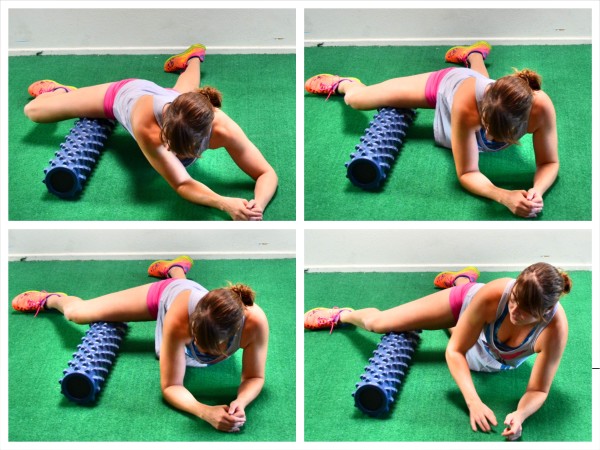
To roll out your adductors, you can use a ball up on some books or even a larger foam ball. However, a roller is best especially if you are less flexible.
Using a roller, lie face down on the ground and bend one knee out to the side at about 90 degrees. Place the roller under the inside of your bent knee. Your other leg will be out straight behind you and you will be slightly rotated toward that bent knee.
Resting on your forearms, rock your leg forward over the roller toward your quad and then back toward your hamstring. You want to work toward the front and the back of the inner thigh right above the knee. Hold on any tight spots.
Then move the roller up your inner thigh toward your groin. Rock forward and backward again, holding on any tight spots.
Work all the way up your inner thigh. As you get closer to your groin, you may even want to rock forward and hit the top of your quad.
8. Hips/Glutes – The muscles around your hips and glutes can be tight causing your glutes not to work properly when you run. This can affect your speed, especially your sprinting power. It can also lead to knee, hip and low back pain and injury.

To roll out your hips and glutes, a small, hard ball is best.
Start by lying on your side on the ground propped up on your forearm. Place the ball under one side right behind your hip at the top of your glute. Move the ball around your glute from the outside of your hip to your tailbone and from the top of your butt to the top of your hamstrings.
Hold on any tight spots you find.
To dig in more when you find a tight spot, lift and lower your bottom leg (the leg of the glute on the ball) up and down off the ground. You can also tuck your knee in toward your chest and then straighten your leg back out. Perform a few reps of each then move the ball to another part of your glutes.
Search all around your glute and focus on the areas of tightness. Really make sure to work from your tailbone out to the side of your hip. You can even work under your hip bone and around to the front of your hip.
As you work under your hip and bring it around to the front of your leg, hold on any tight spots.
If the pressure is too much, use a softer, bigger ball.
9. Psoas – If you sit at a desk all day, you need to loosen up your hips and even your abs so that you can engage and recruit the correct muscles when you run to prevent knee, hip and low back aches and pains.
One muscle especially that you need to target is your Psoas.
To roll out your Psoas and even your abs you can use a larger foam ball or a smaller ball up on some books.

To roll out your Psoas and abs using a smaller ball, place the ball on some books in your abs above your hip to one side of your belly button.
Relax over the ball and lie face down on the ground. Breathe.
Then move the ball, working your way around the side of your lower abs between your belly button and hip. After you move the ball, relax completely back over it.
You can also roll out your upper abs, with the ball. Place the ball on the books and lie over it so the ball is in your abs right below your rib cage.
Relax over the ball and work along the bottom of your rib cage, relaxing over the ball and breathing every time you change the position of the ball.
If you have a posture ball, this tool works best. You will do the exact same thing as with the smaller ball; however, you won’t need the books.
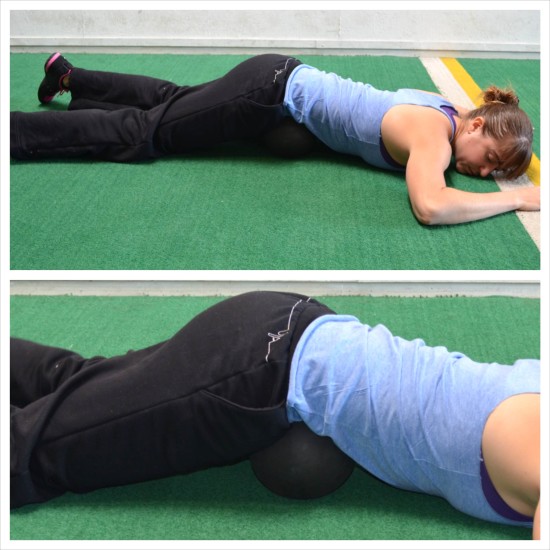
10. Back – While running is mainly considered a lower body activity, your core and even your upper body do contribute and affect how fast and even how efficiently you run. Therefore, if you sit hunched over a computer all day, you need to roll out your entire back and even your chest and shoulders for that matter. This can help you maintain a nice tall posture when you run and lessen any potential neck pain you may suffer from.
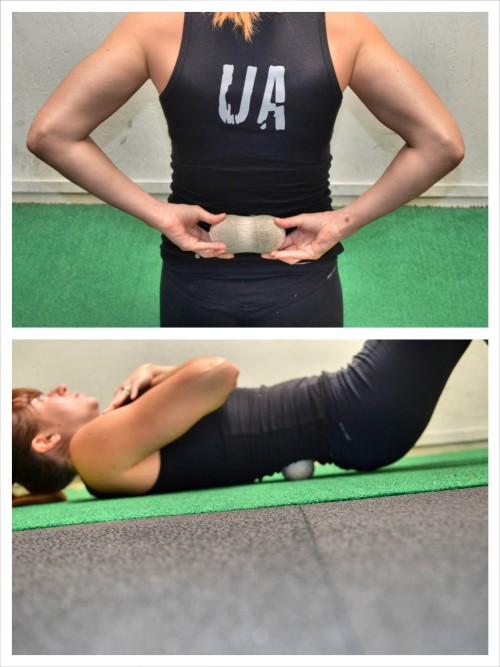
Click here for 5 Quick Upper Body Foam Rolling Moves.
Step 2 – Stretching
Once you’ve foam rolled to loosen up tight muscles, you have to help restore mobility to your joints and flexibility to your muscles by stretching.
Stretching should be included before and after your run. You should even do it throughout the day if you find yourself seated in the same position for hours at a time.
These stretches will loosen up tight muscles that can cause imbalances and improper movement patterns. By loosening up these muscles, you can also restore proper mobility to joints and allow your body to recruit the correct muscles when you run so that you can run faster and further!
Below 10 Must-Do Stretches For Runners.
1. Bear Squat with Foot Stretch – This is a great stretch to loosen up your feet and calves to prevent Plantar Fasciitis, Achilles issues and even ankle and knee pain.
To do the Bear Squat with Foot Stretch, start kneeling on the ground with your feet flexed. Sit back on your heels with your toes tucked under. You can even rock side to side. Feel a nice stretch down the bottom of your feet.
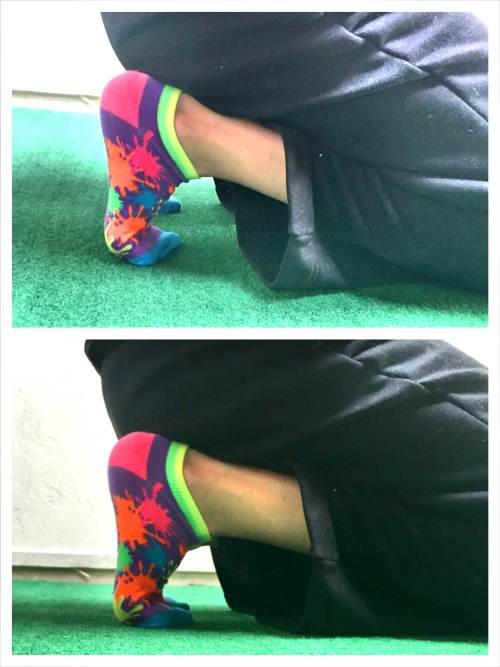
Then place your hands down on the ground and, starting on your hands and knees on the ground with your hands under your shoulders and your knees under your hips, press your butt up into the air and drive your heels down to the ground.
Relax your calves and try to get your heels down to the ground. Feel a nice stretch down your calves and even up into your hamstrings. Hold for 1-2 seconds and then drop back down to your hands and knees.

Make sure that as you drive your butt up, you are pressing yourself back so that you’re driving your heels down. Don’t simply pike up and lower back down. Actually drive back and feel the stretch down your calves.
You can walk your hands in just a little bit closer to your knees to help you feel the stretch a little bit more, but do not walk them in too close.
Once you’ve returned to your hands and knees, sit back onto your heels with your toes tucked under. You can again rock gentle from side to side.
Place your hands back down on the ground and then repeat the Bear Squat.
2. Peroneal Stretch – If you tend to run on the inside of your foot and shoe, your Peroneals are probably tight and this can cause foot, ankle and knee pain.
To stretch out the outside of your Shins and Peroneals, you will want to try this kneeling stretch that may even stretch your quads a bit.
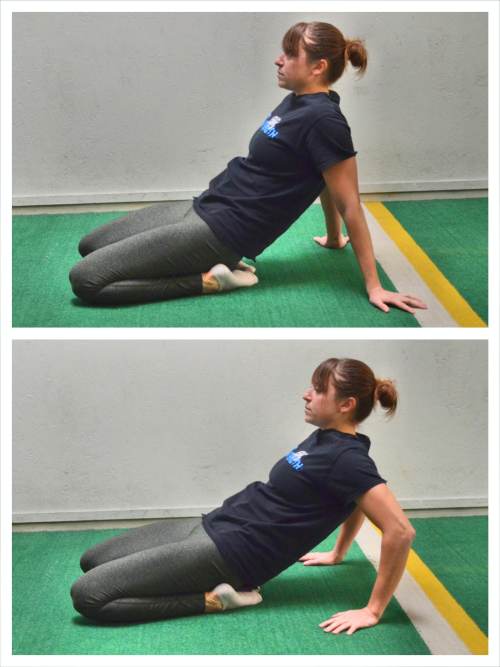
To do the Peroneal Stretch, start kneeling on the ground with your toes pointed and turned in toward each other. Then lean back and relax your butt down onto your feet with your hands behind you on the ground to help support your weight and keep you balanced.
Only sit back as far as you can and relax into the stretch. The more you sit back, the more you’ll feel the stretch. You want to almost rock toward the outside of your foot and relax it onto the ground as you turn your toes in as much as you can while kneeling and leaning back.
Depending on your flexibility, you may want to have a wall or chair behind you if you can’t reach back and touch the ground.
If you can easily touch the ground and lean back, you can even rock back and allow your knees to come up a bit. You can then work to relax them back onto the ground in that rocked back position.
After doing this stretch, you can even then come back to kneeling and flex your feet, tucking your toes under, to stretch out the bottom of your feet and toes and do the Kneeling Foot Stretch that is listed with the Bear Squat above.
Make sure to breathe as you stretch to help yourself stretch further.
This stretch is best done without shoes on.
3. Three-Way Shin Stretch – If you’ve ever suffered from Shin Splints or rolled your ankles, you need to make sure to stretch out your shins using this Three-Way Shin Stretch.

To do the 3-Way Shin Stretch, stand facing a wall or something else you can use for a bit of support and balance if needed. Place your hands on the wall in front of you and extend one leg back, pointing the toe and rocking forward toward the top of your foot.
You want to place the top of your toes down on the ground so that the top of your foot is facing, or even on, the ground.
Then, using the wall to help you balance, bend your knee back and rock a little forward, pressing the top of your foot down toward the ground. Feel a stretch up your shin. Straighten your leg back out and repeat. These may be very small knee bends. Just bend enough to feel a stretch up your shin as you rock forward, dropping the top of your foot toward the ground.
Complete 10 reps. Then change the angle of your toes to hit a different aspect of your lower leg.
You can point your toes straight back, in toward your other foot or outward. To point them outward, you will rock more onto your big toe.
With your toes pointing each of the three ways, bend your knee to feel a stretch down your shin and then relax back out. Complete 10 knee bends in each position then switch sides.
4. Half Kneeling Quad and Hip Stretch – A super important stretch for runners, especially runners with desk jobs is the Half Kneeling Quad and Hip Stretch because it will relax their hips and quads so that they can use their glutes properly and prevent knee, hip and low back pain.
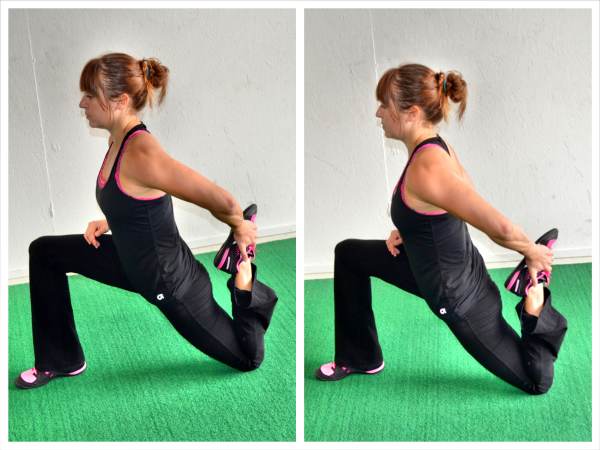
For a number of variations of the Half Kneeling Quad and Hip Stretch to meet your specific needs, check out these 35 Stretches.
5. World’s Greatest Stretch – This is a great full-body stretch if you are short on time and need to stretch your hips, back and hamstrings while also activating your core. Plus if you add in the side lunge at the end, it even gets your adductors!
Basically if you only have 5 minutes, this should be your go-to stretch!
Here is a guide to the World’s Greatest Stretch.
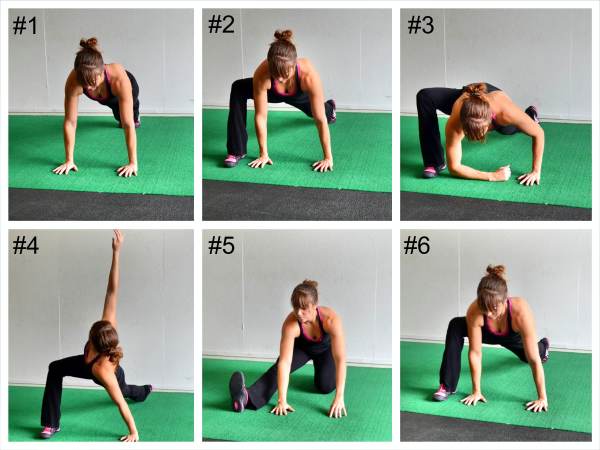
If you add in the side lunge, after sitting back on your hamstring, you will come forward and rotate open, sinking down into a side lunge on that front heel. Make sure to keep that heel down and use your hands on the ground to help you balance.
Turn the toe of your back foot up and feel a stretch in your adductors. Rotate to face back forward and again drop your elbow before rotating open toward the front leg.
Still stay on the same side until all reps are complete.
6. IT Band Stretch – To help prevent knee and hip pain, you need to make sure to stretch your IT Band and the outside of your leg and hip. This move can even help stretch your hamstrings.
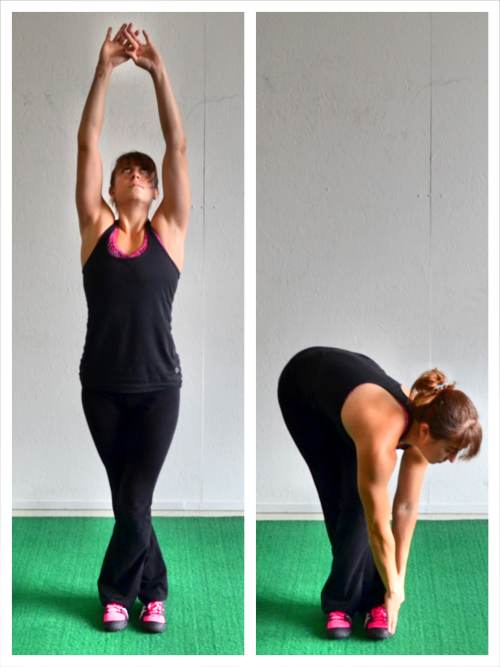
To do the Standing IT Band Stretch, cross one foot behind the other and line up both feet so your toes are even. This will keep your back leg straight so that you get a better stretch. If you are less flexible though, you may not be able to get your toes even. In that case, just focus on keeping your legs straight as you reach over.
Then reach up with both hands and feel a nice stretch through your arms and back and even into your abs and hips.
Hinge over and reach your hands to the ground down outside the instep of your back foot. You will not be reaching straight down but instead slightly to the side to reach the instep of your foot in back.
Push your hip away from the foot you are reaching toward to feel a nice stretch down the side of your leg and even the outside of your glute.
Hold for a second or two then uncross your feet and recross them the other way. Reach up again and then reach back down toward the instep of the back foot.
Keep alternating feet and reaches to stretch both sides. Make sure your toes are even and that you reach toward the instep of the foot in back. Also make sure that you pop your hip out to the side and don’t simply reach over. The more you push your hip out, the more you will feel this stretch working.
7. Frog Stretch – One of the best stretches for your Adductors is the Frog Stretch. This move will help loosen your adductors so that your Lumbo-Pelvic-Hip Complex works correct so that you can run faster and not risk pain or injury.

To do the Frog Stretch, kneel on the ground and spread your knees as wide as possible while also supporting yourself on your forearms.
Turn your toes out as you open your knees as wide as possible and place the inside of your feet against the ground. Do not let your heels come together behind your butt. You want your feet wide apart so that your ankles are in line with your knees if possible.
Bringing your heels together reduces the stretch.
Then sit your butt back toward your heels as much as possible while keeping your knees wide. You may not be able to sit back much, but just push back as far as you can. Feel a nice stretch in your inner thighs and even around the back of your legs.
Breathe as you sit back and feel the stretch. Hold for a second or two and then release out of the stretch, coming back forward for a second before pressing your butt back as far as you can toward your heels again.
As you rock back and forth, you can also work to open your knees up further.
Breathe and relax into the stretch as you go.
8. Pigeon Pose – Another way to loosen up your legs and hips is with the Pigeon Pose Stretch. By opening up your hips, you can improve your gait mechanics and prevent knee, hip and back pain.
And if you sit all day at a desk and suffer from Sciatica at all, this is a must-do move.
Pigeon Pose can be both a great static stretch for after your run or after a long day of sitting or it can be a great dynamic stretch to use before your run if you add in the arm circles.
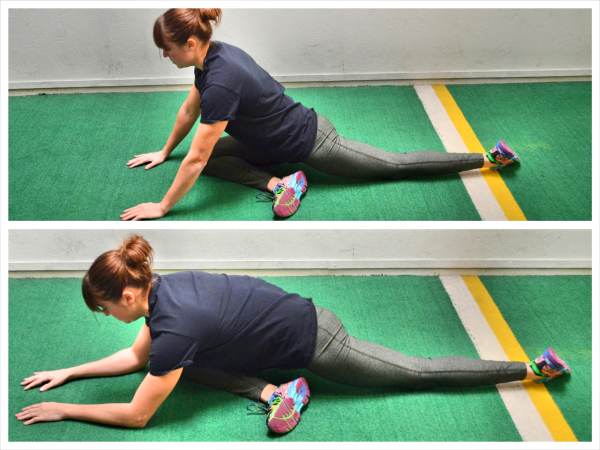
To do the Pigeon Pose, sit on the ground and bring your right foot forward. Angle your right knee toward about “2” on a clock to start. The closer to 90 degrees you bring your front knee, the harder the stretch will be so start with the “2” o’ clock position until you are ready to progress.
If you feel this a lot in the outside of your front knee, make sure you are flexing that right foot.
Then extend your left leg out behind you as much as you can. Turn that back leg slightly inward so you aren’t sitting right on top of your knee cap. By turning your leg in, you will also help square your hips to the ground and you will increase the stretch in both hips.
Holding this position, relax over your front leg. Make sure your hips are facing the ground. Do not move the front leg closer to 90 degrees if your hips aren’t both square to the ground or you will put more pressure on your back.
You can either hold here or make “circles” on the ground with your arms. If you hold this is the static stretch.
If you choose to add in the circles, you will make the move dynamic and hit different aspects of your hips and legs. To do the circles, walk your hands toward the outside of your front hip and then back toward your feet. Feel a nice stretch in your hips as you circle. Try to make as big a circle as you can while leaning forward over that leg and reaching out as far as you can.
Do not let your hips rotate open or your back knee bend as you circle.
Then switch to a Pigeon Pose on the other side and either hold or walk circles with your arms.
9. Camel Stretch – If you sit at a desk all day and then want to go out and rack up the mileage on your runs WITHOUT getting injured, you need to include this stretch into your daily routine.
The Camel Stretch is a great way to open up your chest, hips and quads while also starting to activate your glutes and core.
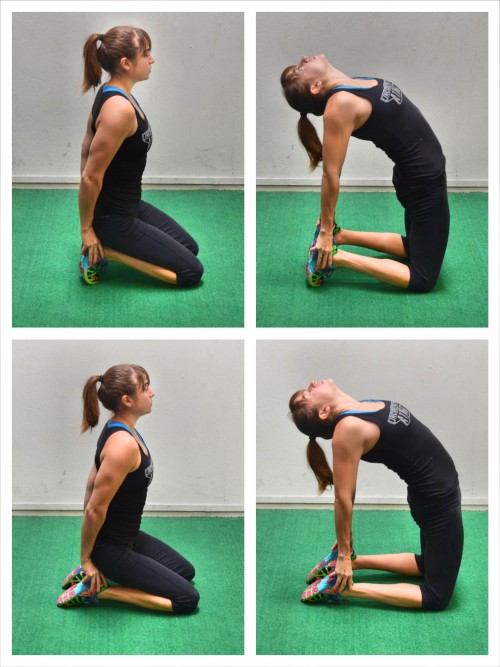
To do the Camel Stretch, start kneeling with your knees about hip-width apart and your feet flexed. Sit back on your heels and place your hands on your heels.
Then arch your hips up and away, lifting your glutes up off your heels and pressing your chest out as you lean your head back. Keep your hands on your heels as you arch away and squeeze your glutes to fully extend your hips.
Feel a nice stretch down your chest, core, hips and quads as you bridge up off your feet. Do not let your shoulders shrug. Also make sure to squeeze your glutes so you don’t just feel this stretch straining your low back.
Hold for 1-2 seconds and relax back down. Repeat, arching back up. You can also make this a static stretch by simply holding the pose for 15-20 seconds.
If you want to make the stretch more challenging, point your toes and place your hands on your heels instead of flexing your feet (the two bottom photos).
If you are less flexible, do this stretch with a couch, chair or table behind you so that you don’t have to reach your heels. Kneel down and place your hands back behind you on the couch or table. If you are at your desk, you can use your desk or chair. Keeping your arms straight behind you, press your chest out and arch away as much as possible away from the piece behind you while leaning your head back.
10. Extended Triangle/Extended Twisting Triangle – Two other great full body stretches to open up your glutes, hips, adductors, back and even hamstrings and calves are the Extended Triangle Poses. These are great moves to do on recovery days or after your runs because they are static stretches,
If you sit all day at a desk or have ankle, knee, hip or back pain from running, you need to include these two moves as stretches around your runs.
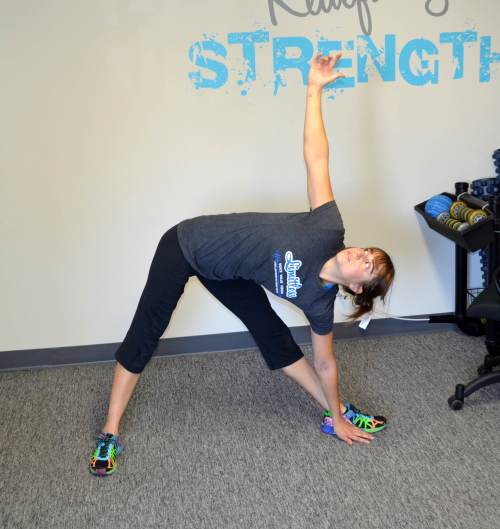
To do the Extended Triangle Pose, set up in a wide lunge stance, stepping one foot forward (with your feet about 4 feet apart). Your front foot should be pointing straight ahead and your back foot turned out.
Your feet should be almost perpendicular. Also, make sure that your front foot is about at the instep of your back foot if you look back from your front heel to your back foot.
Pushing your butt back and hinging at the hips, reach the same hand as the leg that is forward down to the ground. Make sure to keep your legs straight as you hinge. If your legs start to bend, do not reach lower or make sure you are pushing your butt back. You may also find you need to bring your back foot in so your stance isn’t quite as wide to help you keep your legs straight.
Place your hand on the ground at the instep of your foot. You can also place your hand on a block, your foot, your shin or your ankle if you can’t reach the ground while keeping your legs straight.
Extend your opposite arm up toward the ceiling, opening your chest up toward the ceiling. If you can’t really open your chest up toward the ceiling, you may want to place your hand up higher. You can then keep looking at the ground to help you balance or look up toward the ceiling to make the move harder.
Hold that pose and relax and breathe. As you breathe, try to stretch further, making sure to keep both legs straight as you push your butt back and reach toward the ceiling.
Switch and repeat on the other side after holding for at least 15-30 seconds.

To do the Extended Twisting Triangle, you will set up in the same wide lunge stance although you may want to turn your back foot a bit more straight ahead. You may also need to bring your back foot closer in and not be as wide if you struggle to keep your legs straight.
Then keeping your legs straight, hinge at the hips as you push your butt back, dropping the opposite hand from the leg forward down to the ground at about your instep.
Reach your other hand up toward the ceiling and rotate your chest open toward the front leg.
Breathe and relax into the stretch, trying to rotate your chest open as you keep your legs straight. You will feel this stretch a lot in the outside of that front hip and leg.
For even more stretches, especially stretches that are perfect for right before a run when you are standing at the start of the trail, check out these Dynamic Stretches For Runners.
Step 3 – Activation
Once you’ve stretched, you need to get the correct muscles working so you don’t compensate and cause smaller muscles to become overworked, which can lead to pain and injury.
For instance, if your glutes aren’t activated, you may not be able to sprint as fast! You also risk knee, hip and low back pain.
Same go for your adductors. Even though they may be tight, your adductors can also be weak. If your adductors are weak, you risk knee and hip pain and injury.
But these aren’t the only two muscle groups you need to get activated and working.
Below are 10 Must-Do Activation Exercises For Runners:
1. 3-Way Leg Swings – Working on your balance will help improve the strengthen of your feet and lower legs while working to improve the strength of all the little stabilizer muscles up your legs and throughout your core. This will help you prevent foot, ankle, knee, hip and even low back pain so that you can continue running without pain.
And 3-Way Leg Swings are not only a great way to build stability and balance, but they will also warm up your lower legs and hips while activating your core before a run!
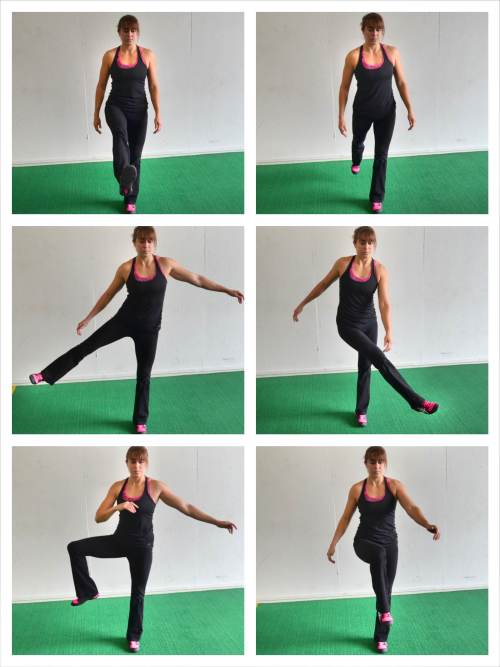
To do 3-Way Leg Swings, start standing on one foot. Keeping both legs fairly straight, but not locked out, swing the other leg forward and backward. Swing from the hip. The bigger your swings are, the more your standing leg will have to work to balance.
Do not hold on to anything as you do this move. If you need to at the beginning, just perform smaller swings and tap your foot down as needed to reset and stabilize.
Perform 10-20 forward/backward swings. Then, still balancing on the same leg, start to swing your leg right to left in front of you, swinging from the hip. Again the bigger the swing, the harder the move will be. Complete 10-20 lateral swings.
After performing the lateral swings, try a rotational swing while still standing on the same leg. Bend the raised knee to 90 degrees with your bent leg out in front of you. Then open the knee out to the side, keeping the knee bent.
Bring the bent leg back in front of you and repeat. Complete 10-20 swings here before performing all three swings on the other leg.
2. Glute Bridge – The Glute Bridge is a must-do activation move for all runners because it opens up the hips and gets those butt cheeks working so you can not only prevent pain and injury but also run faster!
If you sit all day at a desk, this move is even more important because your hips are tight and your glutes are probably inactive.
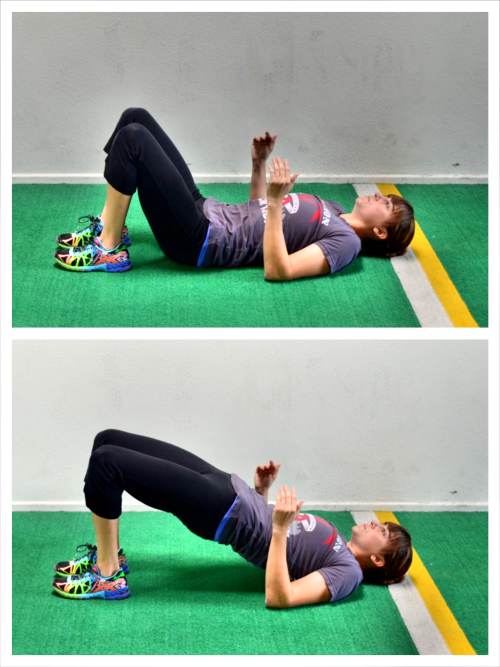
To do the Basic Glute Bridge, bend your knees and put your feet flat on the ground just close enough that you can graze your heels with your fingertips when you stretch your arms down by your side. Your feet should be about hip-width apart.
Adjust your foot position as necessary so that you feel your glutes working and not just your hamstrings. If you only feel your hamstrings adjust your feet a bit further away from your butt or bring them closer. Play around until you feel your glutes working.
Don’t just allow your hamstrings to take over or you won’t get the benefit from this move!
Then bend your elbows to 90 degrees so that only your upper arms are on the ground and drive up through your heels and upper back to lift your glutes off the ground. Drive your hips up as high as possible, squeezing the glutes hard. Keep your belly button drawn in so you don’t hyperextend your back. Focus and consciously squeeze your glutes at the top.
Do not push backward off your heels. Make sure you are driving straight up and that your knees aren’t caving in.
Squeeze your glutes for second or two at the top and lower all the way back down to the ground before repeating.
Do not rush through the move. To make the move harder, hold longer at the top or even slow down the lower back down to the ground. A slower tempo means more time under tension and more work for your glutes.
3. Fire Hydrants/Mini Band Walks or Clams – As a runner, you need to make sure to not only activate your glute maximus, but also you glute medius and minimus. Activation of these two glute muscles will help with hip stability and also help prevent knee and hip pain.
To activate the glute medius and minimus, moves like the Fire Hydrant or even Mini Band Moves like Monster Walks, Side Shuffle and Clams work really well.

To do Fire Hydrants, start on your hands and knees with your hands under your shoulders and your knees under your hips. Flex your feet.
Then, keeping your arms straight and your feet flexed, raise your right leg out to the side with the knee bent to 90 degrees. As you raise your leg out to the side, keep your ankle in line with your knee. Do not let your foot get above your knee or your knee go up above your foot. Your lower leg should stay in line and be parallel to the ground.
Also, don’t simply lean away to get your leg up higher. Keep your core tight and lift from the hip using your glute.
Hold at the top then lower back down. Make sure to hold for 1-2 seconds. Do not rush through the lift.
Make sure you do not bend your arms to get your leg up higher. Squeeze your butt and make sure you feel it activate. Range of motion isn’t important as long as you feel your glute working.
You may even feel this in the glute of the leg down because it is working to stabilize.
Complete all reps on one side before switching.
You can make this move harder by doing a Straight Leg Fire Hydrant Variation.
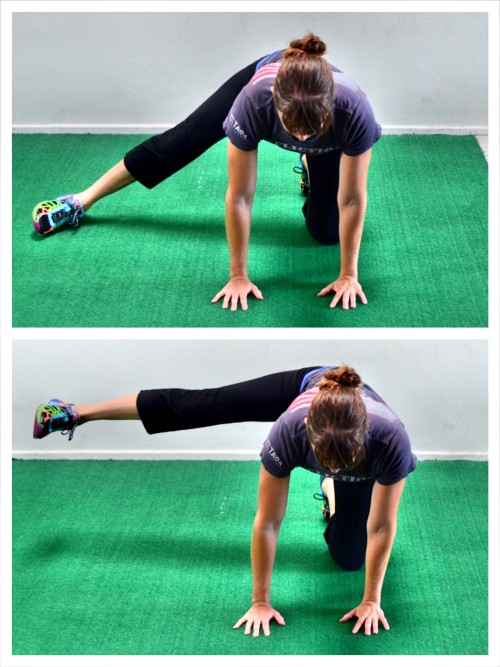
For Mini Band Walks and Clams, and even more great Glute Activation Moves, check out these Best Glute Exercises.
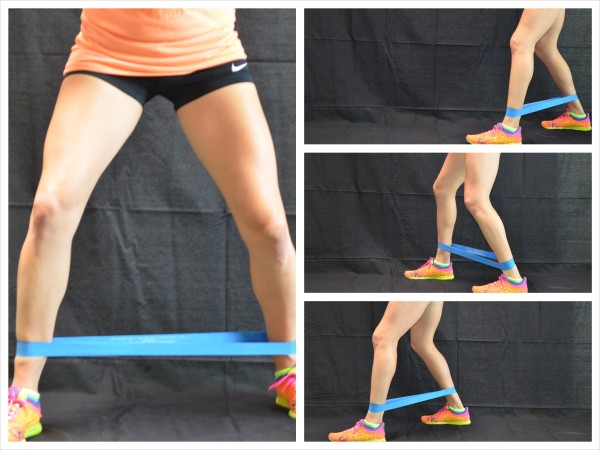
4. Cossacks Squat – Your adductors are a muscle group that can cause problems because they are both tight AND weak. If you want to prevent knee, hip and even back pain, you therefore need to not only foam roll and stretch, but also strengthen through the increased range of motion.
This makes the Cossacks Squat a must-do move for runners because it will help to stretch your adductors to increase your mobility as you strengthen the muscles through this increased range of motion.
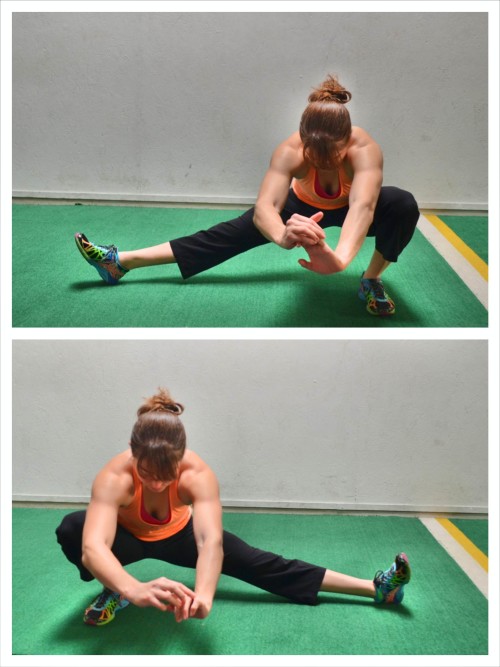
To do the Cossacks Squat, stand with your feet nice and wide apart as if you are going to do a Side Lunge (feet will be wider than shoulder-width). You may even turn your toes just slightly out.
Then shift your weight to one side, bending that knee and sinking down into a side lunge as you rotate the toe of your straight leg up toward the ceiling.
Sink as low to the side as you can, dropping your butt down to the ground while keeping your heel on the ground. You will feel like you are sinking into a deep single leg squat on one side as your other legs stays out straight with the toe rotated up toward the ceiling. You can reach your hands out in front of you to help you keep your chest up and stay balanced.
Then push back up out of the squat and come back to center standing tall with both legs straight. Then shift to a squat on the other side, sitting down as low as you can while keeping your heels down and the other leg out straight.
Beginners may not be able to sink as low in the squat. Do not try to sink lower by squatting down and letting your heel come up. Sink only as low as you can while keeping your heels down. If you struggle to get low, you can use a pole or your hands on the ground or wall to help you balance. However, only go as low as your strength and mobility allows.

5. Pelvic Tilt – The Pelvic Tilt is a basic core activation move to strengthen your deep intrinsic core stabilizers and help you prevent low back and hip pain.
If you sit at a desk all day, even if you spend time at the gym “strengthening” your abs, you may still not be engaging them properly when you workout or run.
And a strong, engaged core is essential to proper running form and efficient, strong movement patterns. For instance, if you want to be able to run faster, you need a stronger core that engages correctly!

Check out this link to learn how to do the Pelvic Tilt Progression and engage your core correctly.
6. Thoracic Bridge with Sit Thru – Like with the Cossack Squats, it is important to improve your mobility as you get the correct muscles activated and working. The Thoracic Bridge with Sit Thru does just that.
This move will activate your core, especially your glutes, while improving your hip and back mobility. If you sit all day at a desk and then want to go run and workout without risking pain or injury, you need to include this activation exercise.
It is even a great move to do before your leg and glute workouts or after a long day at work!
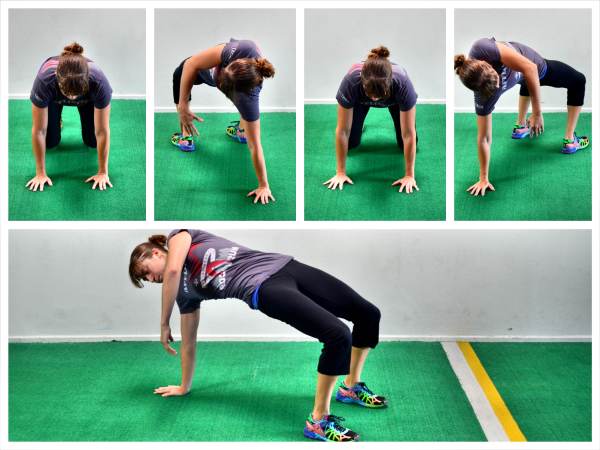
To do the Thoracic Bridge with Sit Thru, set up on your hands and knees with your hands under your shoulders and your knees under your hips. Flex your feet and lift up onto your hands and toes.
Then lift your right hand and bring your left leg through and place your left foot flat on the ground. Rotate your hips up toward the ceiling, squeezing your glutes to lift them up as high as you can.
Then with your hips bridged up and your glutes engaged, reach your right hand down toward the ground, rotating your chest toward the floor.
Feel your glutes working to keep BOTH hips up, while you reach your hand down and feel a nice stretch through your spine. We have a tendency when we rotate to drop the hip on the side we are rotating toward. Make sure to keep both hips up as high as possible.
You should feel a nice rotation and stretch through your spine almost like someone wringing out a towel.
Then drop your hips and step your foot back through while placing your hand back down on the ground. You should be back in that starting position with your knees under your hips and your hands under your shoulders. Do not let your legs straighten out as you sit thru and bridge up to each side.
Step through and rotate to the other side, bridging your hips up as high as you can as you reach toward the ground. Keep alternating sides until all reps are complete.
7. Table Top Bridge – Another great bridge exercise to not only activate your glutes but to also open up your chest and hips to help improve your running form, is the Table Top Bridge.
Because you sit in flexion hunched over a computer all day, you need to make sure to open up your chest before you run or you may suffer from neck and shoulder pain and even not run efficiently.

To do the Table Top Bridge, start seated on the ground with your knees bent and feet flat on the ground in front of you and your hands on the ground behind you. If you are more mobile, your feet may be in closer to your butt.
Drive through your heels and your hands on the ground to bridge your hips up as high as you can, squeezing your glutes to extend your hips. Lean your head back and press your chest out as you bridge up. Feel a nice stretch across your chest and shoulders as well as down your hips. You should also feel your glutes working to bridge you up.
Keep your core tight as you bridge up and try to create a “table” with your body.
Drive your hips up as high as you can without hyperextending your low back. Squeeze your glutes at the top to make sure you are extending your hips as you bridge up and not your low back. You don’t want to engage your low back just to bridge up higher.
Hold for a few seconds at the top then lower back down and repeat.
Keep the core engaged at the top by using the Pelvic Tilt so that you engage your glutes without hyperextending your low back.
8. Front Plank – The Basic Front Plank is a great way to open up your hips and learn how to activate your core. If you do a Front Plank correctly too, you shouldn’t be able to hold it for minutes on end.
A plank done correctly really doesn’t need to be held for more than a minute and your abs should be shaking almost instantly if you are truly engaging.
A great Front Plank Variation to start with is the Basic Forearm Front Plank.

To do the Basic Forearm Front Plank, lie on your stomach and bend your elbows so that you’re propped up on your forearms. Your legs should be straight out behind you with your feet together. Flex your feet and lift up onto your forearms and toes. Your elbows should be stacked under your shoulders and your feet should be together.
Create a nice straight line with your body from your head to your heels, making sure to engage your abs, glutes and quads. You want to tuck your pelvic under to engage your abs as if doing the Pelvic Tilt. You also want to squeeze your glutes and quads to keep your legs straight. Make sure that you are also squeezing your legs together as you hold and driving back through your heels. Do not push forward onto your toes or rock backward so that your shoulders aren’t stacked above your elbows.
As you hold with your body in a nice straight line, do not let your chest sag toward the ground or your upper back round. You want a nice flat upper back.
While holding, don’t just go through the motions. Assess whether the right muscles are engaged and even consciously activate them. If you begin to shake, you know you are engaging the muscles.
Hold in this position for a set amount of time or until your form starts to break down. If you feel this in your low back, assess whether or not you are engaging your abs.
Beginners will want to start with a Plank from their knees or even off an incline to make the move easier.
9. Bird Dog – The Bird Dog is another great core move that focuses on activating your abs and glutes. It is also a contralateral movement, like running, which means it makes the opposite arm and leg work together. It is a great move to help you build core stability.
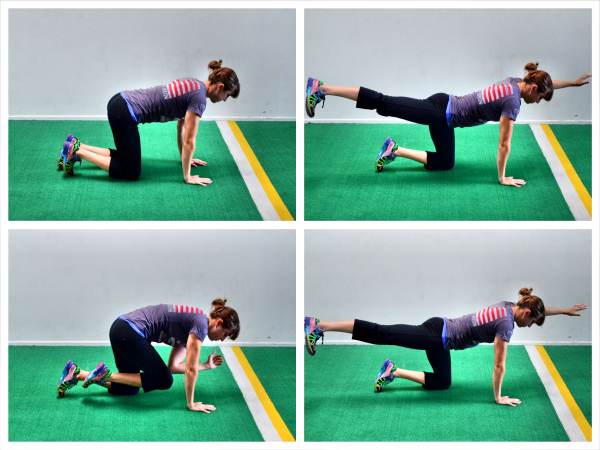
To learn how to do both the Basic and the Advanced Bird Dog Variations, check out these 10 Crunchless Core Moves.
10. Side Plank – The Side Plank is a great Plank Variation to strengthen your obliques and your glute medius. It is a great way to develop and strengthen your lateral, and even posterior, hip and core muscles so that you have more hip and core stability and strength. Including Side Planks can help you prevent hip and knee pain.
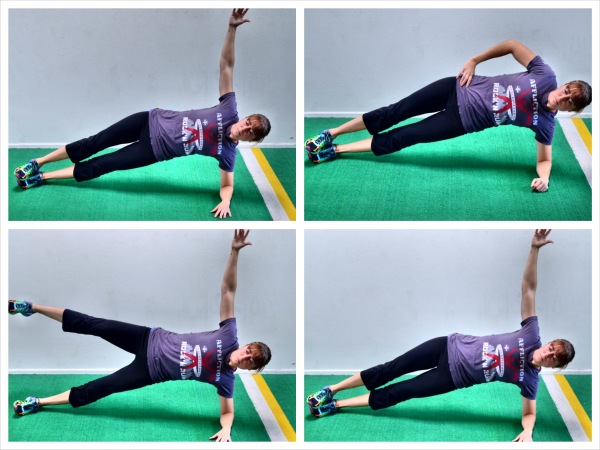
To do the Basic Forearm Side Plank, set up on your side and prop yourself up on your forearm with your elbow right below your shoulder and your legs out straight. You can then either stack your feet or place your top foot on the ground in front of your bottom foot.
Driving through your forearm and the sides of your feet, lift your bottom hip up off the ground as high as possible while keeping your body in a nice straight line. Squeeze your belly button in toward your spine and keep your glutes tight. Do not let your chest rotate forward toward the ground or your top hand touch the ground. Keep your top hand on your hip or reach it up toward the ceiling.
Also make sure to engage your glutes to keep your body in a nice straight and get the correct muscles working. Do not stick your butt back as you hold. Consciously squeeze your glutes and even press your hips slightly forward.
Hold with your hips up and your body in a nice straight line. Concentrate on engaging the correct muscles.
If you want to advance the Basic Side Plank and work the glute medius even more, add in a Leg Lift. To do the Leg Lift, hold the Side Plank and then lift and lower your top leg up and down. Do not let your hips drop toward the ground as you lift the top leg. Also, do not let your butt go back or your chest rotate toward the ground.
Only add in the Leg Lift if you can still perform the Side Plank with proper form (shown in the bottom two photos).
For More Activation Moves:
Isometric Exercises such as Warrior III, Crescent and the Bull Dog Hold can also be great ways to build stability and strength and get the correct muscles working to help prevent injury.
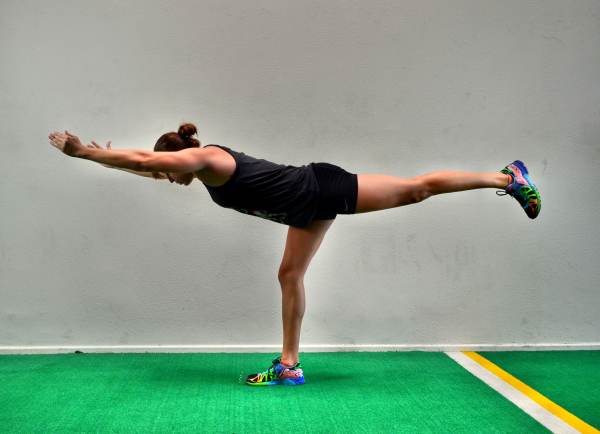
These Isometric Moves are similar to the Cossacks Squat in that they improve your mobility while increasing your strength through the full range of motion.
If you are short on time and need a quick warm up that will stretch and activate all in one, or if you are looking for a quick recovery workout, you should try some of these Isometric Moves!
Step 4 – Strength Training
While running may be your main workout and the type of workout you enjoy the most, you still need to include strength training in your workout routine, to not only keep your body healthy, but to also help you run further and faster.
Below are 10 Must-Do Strength Training Moves For Runners that will help you strengthen your legs, core, back and glutes so that you can avoid common running injuries and even become a better, stronger, more efficient runner!
1. Weighted Glute Bridge and Hip Thrusters – Glute Bridges are not only a great move to stretch your hips and activate your glutes, but they can also be a great way to really build great glute and core strength.
Unlike Deadlifts and Squats that can work your entire leg, Weighted Glute Bridges and Hip Thrusters really focus on and target your glutes.
They activate more gluteal muscle fibers than Squats or Deadlifts, and unlike Squats or Deadlifts where you can actually compensate and not truly strengthen your glutes, Glute Bridges and Thrusters really allow you to isolate and force your glutes to work.
Weighted Glute Bridges:

To do Weighted Glute Bridges, a barbell works best although you can use a kettlebell or even plate weight as well.
Using a barbell, sit on the ground with your legs out straight and roll or place the barbell over your hips. Lie back and bend your knees, placing your feet flat on the ground and your heels close to your butt. Play around with your exact foot positioning so that you feel your glutes working during the movement and not simply your hamstrings taking over.
Holding on to the barbell and pressing it down toward your thighs, bridge your hips up and squeeze your glutes. Make sure to drive through your heels and upper back to lift straight up and extend your hips while keeping your core tight.
Do not let your knees fall open and do not hyperextend your low back as you squeeze your glutes at the top.
Hold for a second or two and lower back down.
As you lift, you may find you want to press the barbell down and away onto your thighs to help you squeeze your glutes at the top and keep your core engaged. Before bridging up, you may find it helpful to first perform the Pelvic Tilt so that your abs are engaged when you bridge.
Add weight to progress the movement as long as you continue to engage your glutes and fully extend your hips.
Thrusters:
Thrusters are another great bridge exercise to help you work your glutes. If you want to add weight to the Thruster, you can do the Barbell Hip Thruster Variation below.
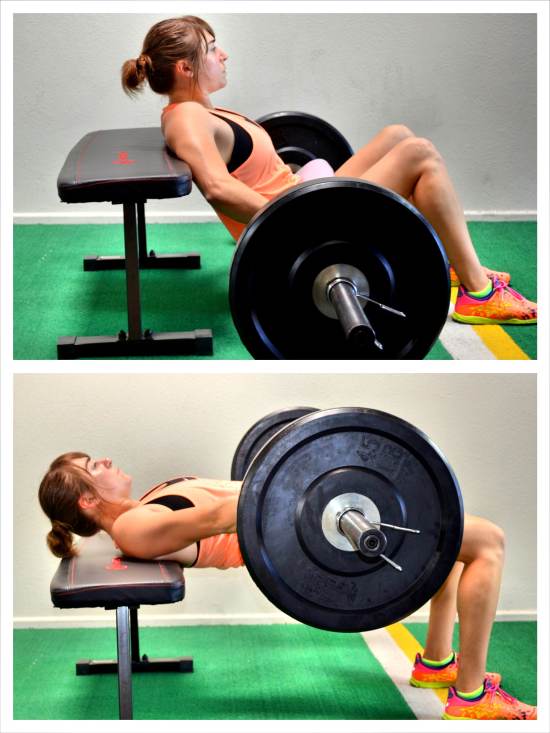
To do the Barbell Hip Thruster, place your upper back on a bench and sit your butt on the ground in front of it with your legs out straight. Place the barbell over your hips and plant your feet firmly on the ground close to your butt. Play around with your exact foot positioning so that you can drive through your heels and engage your glutes as you bridge up. Do not let your quads or hamstrings take over.
Holding on to the barbell, bridge up, driving up through your heels and your upper back on the bench. Fully extend your hips and squeeze your glutes as you bridge the barbell up toward the ceiling.
Squeeze your glutes and press your hips up as high as possible without hyperextending your low back. Keep your abs engaged and hold for a second or two at the top. Then lower back down and repeat.
Do not hyperextend your back at the top. Keep your belly button pulled in toward your spine and really squeeze your glutes at the top. Make sure you are driving straight up through your heels and not pushing yourself backward over the bench.
You may find that as you bridge up you want to “push” the barbell down toward your thighs to help you drive up and squeeze your glutes. You may also find it easier to keep your abs engaged if you perform the Pelvic Tilt before you bridge up.
For more Glute Bridge and Thruster Variations to strengthen your glutes, check out these 20 Bridge Variations.
2. Reverse Hypers – Reverse Hypers are another great move to strengthen your glutes and help improve your running speed.
You can do Reverse Hypers with either Straight Legs or Bent Knees.

To do the Bent-Knee Reverse Hypers, lie face down on a bench, box or table. Place your hips right on the edge of the bench and hold on to the bench or something in front of you. Keep your upper body relaxed as you hold.
If your hips are too far on the bench, you are more likely to hyperextend your low back in an attempt to get your hips up higher so make sure your hips are on the edge of the bench, but not too far off.
Place your heels together and bend your knees to about 90 degrees. Flex your feet. You can choose to turn your toes out to hit a slightly different aspect of your glutes as well.
Then, with your knees bent, kick your heels back and up toward the ceiling, squeezing your glutes to lift as you press your hips and pubic bone down into the bench. You can sort of drive up and out a bit to really get your glutes to work. Make sure to squeeze your glutes and brace your core as you drive your heels up and extend your hips. You do not want your low back taking over.
Lift your legs and extend your hips so that you raise your legs and quads to about parallel to the ground. Then lower back down.
Only lift higher if you don’t feel your lower back take over. You want to focus on and make sure your glutes are working to lift NOT your low back. The most important part is that you feel your glutes tighten and that you are extending from your hips.
Hold at the top for a second or two and then lower back down.
You can vary this move by doing a Straight Leg Variation that may work your hamstrings a bit more.
3. Single Leg Deadlifts – You should include unilateral exercises (single leg exercises) in your workouts to help correct imbalances and even build your core strength and balance. When you force each leg to work independently, your dominant side can’t take over and compensate. This allows you to strengthen both sides evenly so that your weaker side can get stronger.
To work on your balance and core stability while not only correcting imbalances but also strengthening your hamstrings and glutes, you need to do the Single Leg Deadlift.
The Single Leg Deadlift is a great Deadlift Variation for runners because it is a unilateral move that will help them build hip, knee and ankle stability while also being easy and safe on the knees.
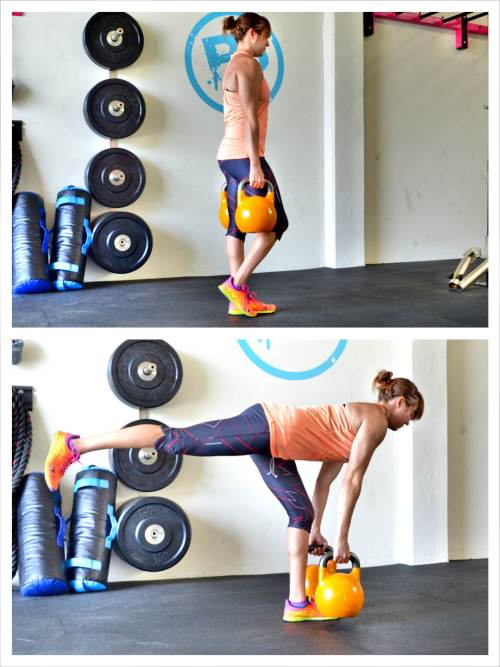
To do the Single Leg Deadlift (using kettlebells although you can also use dumbbells, sandbags or a barbell), hold a kettlebell in each hand down by your sides. Stand on your right leg with your knee slightly bent and your left toe lightly touching the ground.
Then raise your left leg back toward the wall behind you as you hinge over, keeping your back flat. Make sure your hips stay level and you really reach your butt back as you hinge over. Also make sure to drop the kettlebells down and back toward your foot on the ground instead of reaching them out in front of you.
Also do not worry about the kettlebells touching the ground. If your mobility allows you to touch them down great, but do not reach them toward the ground and let your back round. Only lower them as far as you can without rounding or “squatting.”
Your standing knee should be soft as you hinge over and push your butt back but you shouldn’t start to squat as you hinge over.
Make sure that as you hinge over you sit back in your standing heel and then drive through your heel to come back up to standing. You want to feel your hamstring and glute work. You want to really focus on pushing your butt back as you hinge over instead of simply leaning forward.
This move only works if you load that glute.
Also make sure that at the top of the move, you come completely up to standing and squeeze your glutes. Do not touch that other foot down until you are standing. You do not want the other leg to assist you in performing the full range of motion.
For more Deadlift Variations, check out this post on The Deadlift.
4. Airborne Lunges – While Single Leg Squats are a great unilateral move, they can be harder on the knees. They can also perpetuate hip and quad dominance since they are just another hip flexion move.
However, if you still want to include some Single Leg Squat Variation in your workout routine, you should consider the Airborne Lunge. The Airborne Lunge isn’t as much of a hip flexion move and is easier on the knees while still really working your legs and glutes. It will also improve your balance and core strength.
And because it is also a Unilateral Move, it will also help correct imbalances between your two sides.

To do the Airborne Lunge, stand on your right foot and bend your left knee, bringing your heel back up toward your butt.
Then begin to bend your right knee as you hinge over and sit your butt back. You are going to lunge down, dropping your left knee to the ground. Do not touch the left foot down when you drop the knee to the ground.
Also make sure not to reach the left knee back too far when you lunge down. Keep it just a little behind your right foot so that you are almost slightly squatting.
Lean forward as needed to counterbalance but do not round your back forward. You want to hinge forward at the hips as you sit your butt back.
To come back to standing, drive up through your right heel and feel your leg and glute work to straighten your leg as you bring the left knee up off the ground. Come up to standing nice and tall.
Complete all reps on one side before switching. Make sure you engage your core and keep your standing heel on the ground at all times. Do not let your standing heel come up as you touch your other knee down.
Also, make sure you feel this move in the glute of your standing leg and not your low back.
To advance this move, you can add weight.
Beginners may not be able to touch their knee to the ground or they may need to use the Suspension Trainer to help them balance. (Click here for a description of the Beginner Airborne Lunge also called the Single Leg Lunge.)
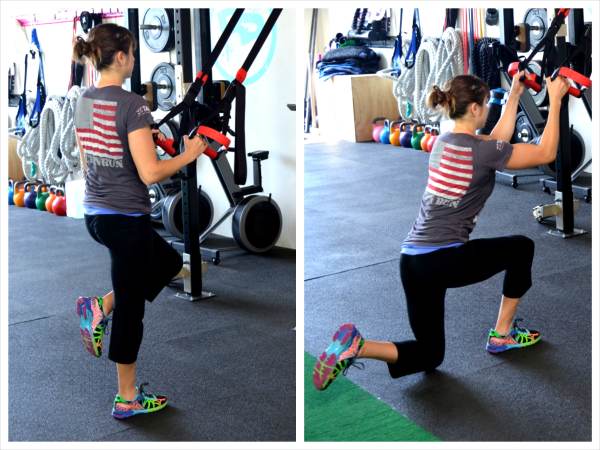
5. Lunge Matrix – Running is a repetitive movement – a repetitive movement done only in the Sagittal Plane of motion. This repetitive movement can cause injury. It can also make us very weak and immobile in other planes of motion, which could lead to injury when we are forced to twist or even move laterally suddenly.
Therefore, you need to make sure that your workouts include movements in every plane of motion.
The Lunge Matrix is a great lunge series to include in your workouts because it will create mobility, stability and strength in your legs and hips by moving your body in every direction.
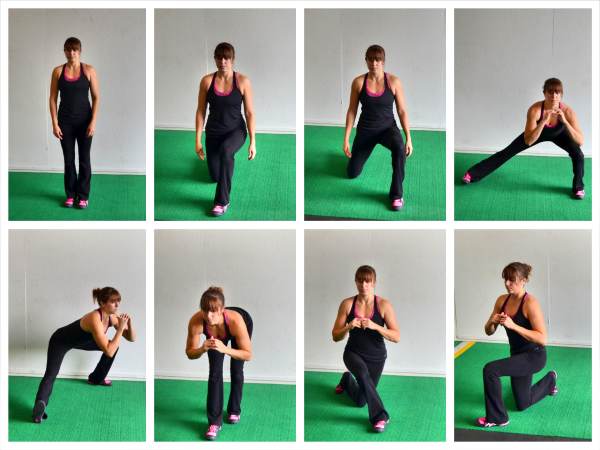
It will help you prevent and alleviate lower body injuries and help you be able to react and move in every plane of motion.
Check out this post for a complete guide to the Lunge Matrix.
6. Hanging Ab Exercises – If you want to develop back, core and quad strength, you should include Hanging Ab Exercises in your workout routine. These moves are way better at strengthening your core than traditional crunches while also working more muscle groups at once to help you burn more calories and develop full-body strength.
And because these Hanging Core Moves improve your back strength, they will help improve your posture when you run.
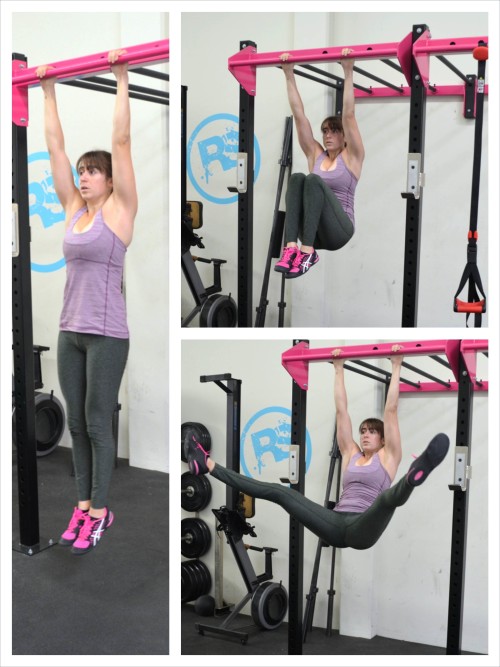
Check out these 10 Hanging Core Exercises.
(BONUS! These moves will also help improve your pull ups!)
7. Sled Sprints – Even if you are a long distance runner, you need to include sprints in your workout routine. And there is no better way to develop great core and leg strength while working on your sprinting power than with Sled Sprints.
Sled Sprints are a great way to strengthen your legs while really improving your conditioning.
To do Sled Sprints aka Sled Push, place each hand on a pole of the sled. Then straighten your arms out overhead and brace your core. Begin to sprint forward, pushing the sled with your arms locked out. Keep your upper body in a nice straight line as you lean your chest over and sprint as fast as you can.
Go as fast as you can for a set length then rest. If you really want to work on speed, don’t go too heavy so that your pushes are slow. Keep it light enough that you can still go fast.
You can also vary the weight depending on what your goals are for the sled push though. If you are doing short, power intervals, you may want to go as heavy as possible and sprint all out for 5-10 seconds.
Or if you want to work on endurance instead of sprinting, you may want to go lighter at a moderate pace for a longer time.
By changing up the weight, you can also focus more on perfecting your sprinting mechanics (by going lighter) or on developing strength and power (by adding weight).
You can even use the Sled Push for an active RECOVERY workout because the sled push movement is focused on the concentric portion of the lift and not the eccentric so that you won’t tear down your muscles near as much while still strengthening your legs.
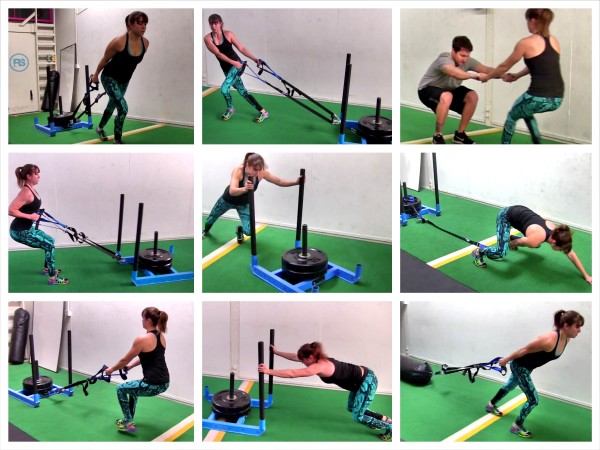
For more exercises using the Sled, check out this Sled Workouts post.
8. Crawling – Crawling is another great cardio exercise that will not improve your conditioning for running but also strengthen your entire core. Plus it is a great move that you can do anywhere while giving your body a break from running.
With Crawling Exercises, you can also move in every direction so that your body is strong and mobile in every plane of motion.

For 21 Crawling Exercises, check out this post and video.
9. Wood Choppers – A great rotational core move to improve your triple extension (aka the extension of your ankle, knee and hip as you pivot or even push off when you run) is the Wood Chopper.
The Wood Chopper can be done with dumbbells or resistance bands and can be done from Low to High or High to Low.

Low-To-High Woodchopper (bottom two photos):
To do the Low-to-High Wood Chopper, place a band around a low anchor point. Grab the handle of the band in both hands and walk away from the anchor point so that there is tension in the band.
Stand with your feet about shoulder-width apart and your side to the anchor point. Then pivot your feet and bend your knees to reach the handle down outside the knee closest to the anchor point. Make sure there is still tension in the band. If there isn’t, walk further out.
Your arms should be straight and your chest should be up as you lunge down. Do not round your back to reach lower although you can hinge over at the hips. Bend your knees and bring the hands outside your knee.
Then bring your arms up and across your body as you stand up and pivot toward the opposite side. You should end up reaching out at about shoulder height with your arms straight. Do not reach up too high as you reach across. Make sure to pivot your back leg so that it is in triple extension and your ankle, knee and hip are all in line. This will protect your knee and help you engage your glute to power the rotation.
Then control the band back down and across as you pivot and bend your knees. Move in a slow and controlled fashion back down into a lunge with your hands outside your knee. Do not let the band pull you. Then rotate and pull the band back up and across.
Complete all reps on one side before switching.
High-To-Low Chop (top two photos):
The High-To-Low Chop is just the opposite of the Low-to-High Chop.
To do the High-to-Low Wood Chopper, anchor the band up high and reverse your position. You will start with your arms reaching up and outside your shoulder closest to the anchor point. Make sure there is tension on the band. Your back leg should be in triple extension with your ankle, knee and hip all in line. (This position will also protect your knee since everything is properly aligned.)
Then pivot and bend your knees to bring the band down and across your body to outside your opposite knee. Once you’ve brought the band outside your knee, you will then pivot back to standing, bringing the band across your body and up outside your shoulder. Move slowly and make sure there is tension on the band the entire way.
When you bring the band down and across your body, do not round your back to reach lower as you bring the band down. Keep your chest up. Just reach down outside the knee as you pivot your feet.
With both moves, you need to keep tension on the band at all times and stay in control of the movement. Do not let the band pull you back.
And you want to make sure to pivot your feet. When you pivot, you keep your knee in a safe position. Plus the pivot puts your back leg in triple extension, which is an important position to generate more force and power.
10. Agility Ladder – Sometimes strength training means improving your mind-body connection and working on your ability to react quickly and change direction even if you are a long distance runner.
Using the Agility Ladder will improve your mind-body connection while improving your body’s ability to recruit the proper muscles quickly and efficiently so you can run faster. It will also improve your stability and balance.
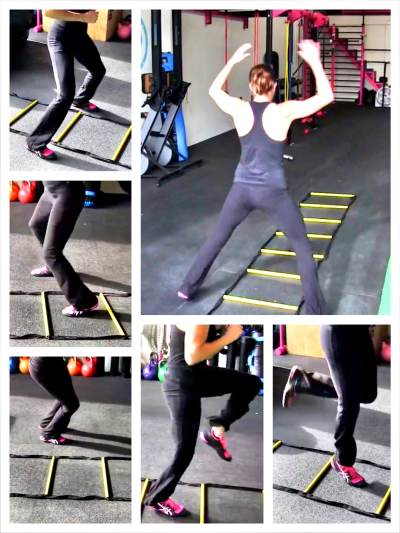
Check out these Agility Ladder Drills to improve your coordination and mind-body connection.
Following these four steps – Foam Rolling, Stretching, Activation and Strength Training – you can prevent and alleviate common running injuries.
Do not skip one of these steps if you want to stay healthy and even run faster and further!
While you log the miles on the road and trail, you also need to make sure to take care of your body when you aren’t running.
For a great recovery workout, check out this Runner’s Recovery Workout with Isometric Exercises.
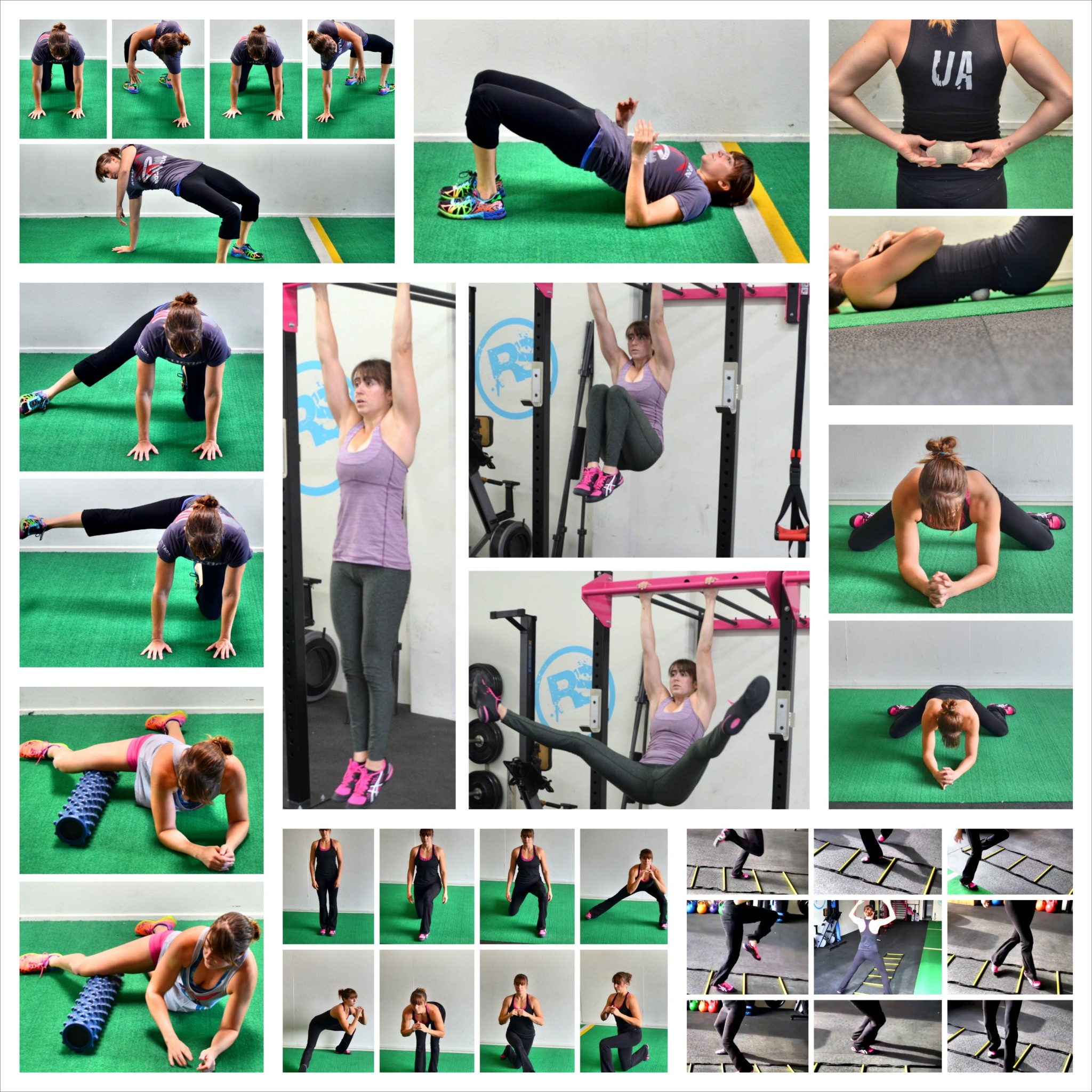
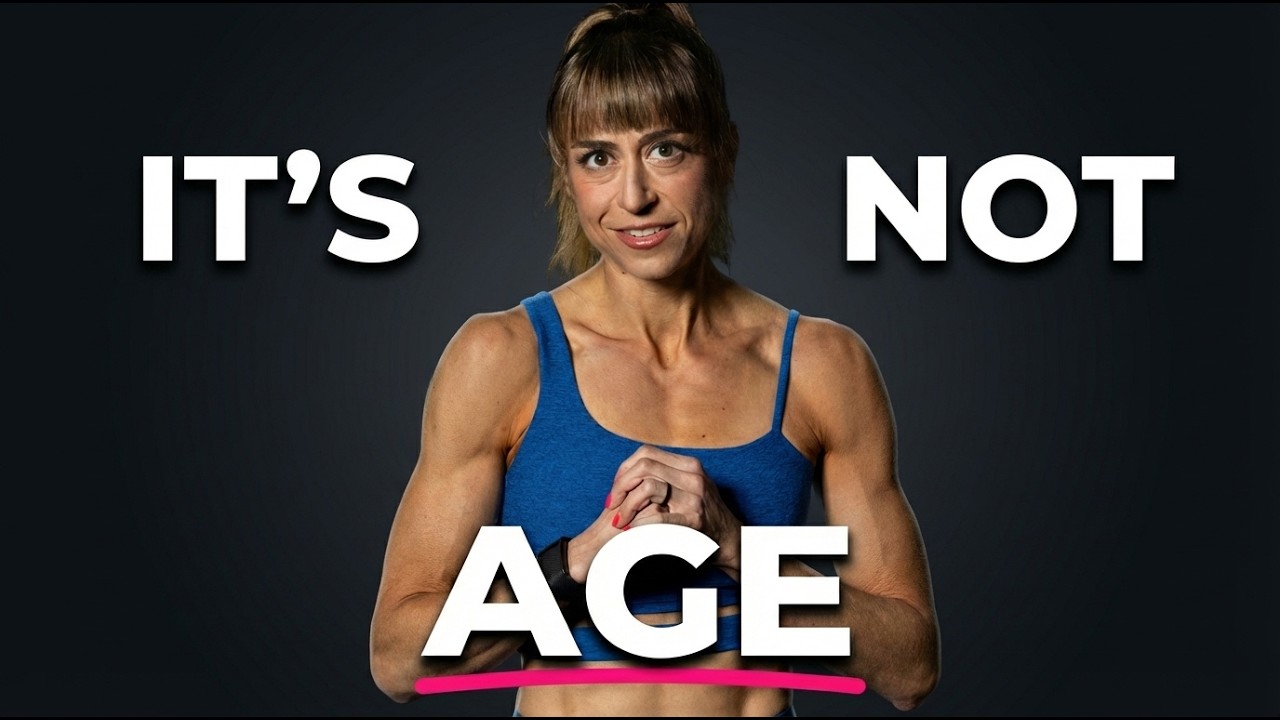

So it takes 4 1/2 years to get a supportive comment for outstanding programs like this? Come on folks!
Thanks Cori. Training guides don’t get any better than this.
Thank you John! Sorry I missed this comment before! Glad the article helps!